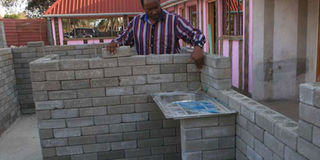Thinking outside the box: Innovation as an avenue for affordable housing in Africa

Stone Centre director Ndegwa Mureithi explains how his company builds houses as per the desires of customers, at his Kiganjo factory in Nyeri County on October 13, 2016. Government officials themselves should begin to support alternative building technologies. PHOTO | JOSEPH KANYI | NATION MEDIA GROUP
What you need to know:
- Civil servants and senior government officials should be given living quarters entirely constructed from alternative building technologies.
- Create a value chain that sustains the alternative building technology industry.
Thinking outside the box is now a standard trope, a cliché even.
However, let us allow ourselves for a moment, let us borrow the phrase.
Quite literally, we should think outside the box when we view affordable housing or all housing for that matter.
By box, I mean the standard square-shaped 150 sq m, three-bedroom apartment. What if it was not box shaped?
What if the shape of the building were circular, or unconventional? Part of what informs our choices are the range of options available, we all settle to live inside the box because that is usually what is presented.
TOURISTS
Semantics aside, this is not about the shape of things or contemporary African architecture, it is about challenging the status-quo, about pushing for innovation.
There is a range of affordable housing solutions, which are dead on arrival in Africa because we still insist on brick and mortar, it is what we know, it is what we trust to be safe.
Once again, our choices are informed by the range of options we are presented with, the imagination is limited by what you know to be possible or true.
Foreigners flock to Africa for the authentic or indigenous African experience; they part with their coin for hotels or resorts that use thatch roof and African-style huts, some of us locals even participate in this.
However, if you were to ask Africans to live in houses that were an upgrade on our indigenous architecture with alternative building materials, you would be met with derision and ridicule.
IDENTITY
Even for those who cannot presently afford a conventional house or who are not likely to afford it in the near future, they would still prefer to wait it out.
Even when presented with the opportunity to own their own homes built with alternative building technologies, they wait it out.
Now the reasons for this are as much cultural as they are systemic, and we must address them.
To begin with, owning a patch of this earth is as central to African identity as, say, dance, or in our case, ugali.
In a previous post, I noted that housing is a human issue, but I will elaborate. To be human is to expect, it is to hope, it is to aspire, and that is where the matter is.
Housing is an aspirational issue.
CULTURE
When most of us dream of owning our homes we imagine castles, the one place in the world that is the most accurate projection of us.
Those dreams are constructed in brick and mortar, not in sand, mud or plastic.
But this is a cultural issue, and culture is malleable, especially when introduced to new information.
Another factor to contend with is the system. There are many advocates for prefabricated materials, for instance, but it still needs to be imported.
This has a direct effect on the pricing, making alternative building materials not as affordable as we would like.
And when they need to be repaired or maintained, owners will play a premium for the expertise.
BUILDING TECHNOLOGIES
The solutions to both these factors are available. This is true at least at the surface-level, culture can be fixed as we noted, it can be edited.
The list of things that were culturally unacceptable just 50 years ago but are widely accepted as the norm today are too long to cite.
However, one of the most direct ways this will happen is if government officials themselves begin to support alternative building technologies by actively participating in them.
Civil servants and senior government officials should be given living quarters entirely constructed from alternative building technologies.
Nothing shapes norms and culture by what our leaders deem permissible and what they do.
INNOVATION
The second solution seems obvious as well. Create a value chain that sustains the alternative building technology industry.
This has inherent faults, first of which is that creating a value chain means that there is an intrinsic value; if the culture has not been established, it will do little good as there will be no demand.
More importantly, we must create an appetite for innovation, and this goes beyond housing.
How often have we reshaped the curricula of our secondary schools and universities?
Are we producing graduates and thinkers who are ready and able to innovate?
EDUCATION
Are our educational requirements aligned with the strategic vision for our economies?
How can we possibly hope to move to a knowledge economy when we have not created the knowledge systems necessary for them?.
This is where the problem for housing and most industries begins.
I overheard a conversation the other day; someone admitted that the curriculum he studied while in secondary school has remained largely unchanged.
I dearly hope this is not true. If not, we can continue to expect to think, live and ultimately be limited by that box.
Femi Adewole is Managing Director of Shelter Afrique, a Pan-African Housing Institution. The views expressed in this commentary are those of the author alone.





